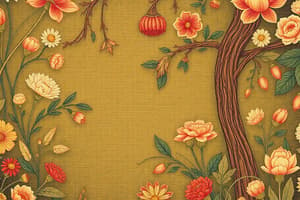Podcast
Questions and Answers
____ refers to a prolongation of a point, or a mark on a surface.
____ refers to a prolongation of a point, or a mark on a surface.
LINE
An area with boundaries identified or drawn using ____.
An area with boundaries identified or drawn using ____.
LINE
Solid portion of a three-dimensional object is known as ____.
Solid portion of a three-dimensional object is known as ____.
MASS
Hue refers to the basic or pure ____, and is represented in the color wheel.
Hue refers to the basic or pure ____, and is represented in the color wheel.
____ refers to the lightness and darkness of color.
____ refers to the lightness and darkness of color.
____ involves using the same hue but with different gradients of value.
____ involves using the same hue but with different gradients of value.
______ refers to lightness or darkness of an area. This element is evident in creating shadows.
______ refers to lightness or darkness of an area. This element is evident in creating shadows.
______ refers to the feel or appearance of a surface. Texture may also be described as actual or implied.
______ refers to the feel or appearance of a surface. Texture may also be described as actual or implied.
______ can be felt tangibly based on the material that is used for the artwork.
______ can be felt tangibly based on the material that is used for the artwork.
______ refers to the area that is occupied by an object or a subject.
______ refers to the area that is occupied by an object or a subject.
______ involves the use of vanishing points and receding hidden lines.
______ involves the use of vanishing points and receding hidden lines.
______ refers to the process of applying color on a flat surface. Considered two-dimensional, meaning it only has height and width.
______ refers to the process of applying color on a flat surface. Considered two-dimensional, meaning it only has height and width.
Flashcards are hidden until you start studying
Study Notes
Line
- A prolongation of a point or a mark on a surface
- Solid lines define form, while broken lines suggest hidden forms
Shape
- An area with boundaries identified or drawn using lines
- Organic shapes are 2D and have length and height
- Geometric shapes are 3D and have height, length, and depth
Mass
- A solid portion of a 3D object
Color
- A visual perception that allows people to differentiate objects due to the way various wavelengths of light are reflected
- A crucial element in communicating information and emotion to the viewer
Color Properties
- Hue: the basic or pure color, represented in the color wheel
- Value: the lightness and darkness of a color
- Saturation: the brightness and dullness of a color
- Bright colors: same pigment with the same hue
- Dull colors: start adding grey colors
Color Wheel
- A combination of primary, secondary, and tertiary colors
Color Schemes
- Monochromatic: uses the same hue with different gradients of value
- Analogous: uses three or four adjacent colors in the color wheel
- Complementary: uses a color and its complement (the color located opposite in the color wheel)
- Split-Complementary: uses the two colors adjacent to the complement
- Triadic: uses three colors of equal distance from each other
- Tetradic (Double Complementary): uses two pairs of complementary colors
Value
- Refers to the lightness or darkness of an area
- Creates shadows and contrasts in art
Texture
- Refers to the feel or appearance of a surface
- Can be actual or implied
- Two types of texture:
- Actual texture: can be felt tangibly based on the material used
- Implied texture: can be exhibited in a painting, such as the fur of an animal
Space
- Refers to the area occupied by an object or subject
- Two types of perspective:
- Atmospheric perspective: uses the properties of light and air
- Linear perspective: uses vanishing points and receding hidden lines
Time and Motion
- Can be an illusion or an actual motion
- Actual motion is seen in kinetic sculpture, which moves with the wind or vibrates with the surrounding air
Painting
- Refers to the process of applying color on a flat surface
- Considered two-dimensional, with height and width only
Forms of Painting
- Easel painting: involves applying color to a board or canvas on an upright support
- Murals: huge wall-sized paintings
- New mural: developed to prevent erasure from the wall
- Portable mural: uses bold strokes and bright colors on pieces of cheesecloth or canvas
- Telon painting: used as a backdrop or background for the stage
- Jeepney and calesa painting: evolved from calesa painting, with logos, numbers, or paintings on jeepneys
Studying That Suits You
Use AI to generate personalized quizzes and flashcards to suit your learning preferences.




